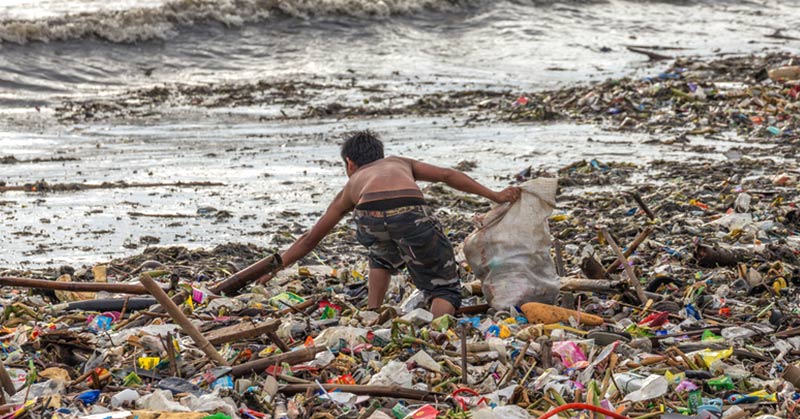While soaking up the sun and listening to the relaxing sounds of crashing waves on the beach, you probably don’t want to think about how the ocean has basically become one gigantic bowl of garbage soup.
Every single day, plastic spreads into our oceans in the name of profit and convenience. Environmentalists and so many other’s have tried to raise their voices about this issue, only to be fallen on deaf ears. It’s as though people are not fully grasping the abuse we are subjecting our planet (our home) to.
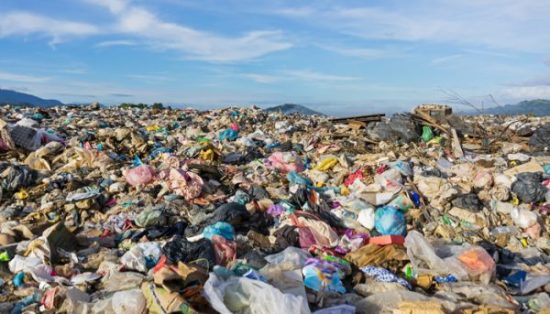
Plastic pollution is one of the biggest threats to oceans (and our planet) worldwide. Since the 1950s, 8.3bn tons of plastic have been produced worldwide, and to date, only 9% of that has been recycled.
In spite of society’s many efforts to properly dispose of plastic waste, between 4 and 12 million metric tons of plastic waste enter the ocean each year—enough to cover every foot of coastline on the planet. (11)
How Big is the Problem?
The plastic-tide is growing by 8 million metric tonnes a year. If nothing changes, it’s estimated that this figure will rise to 80 million metric tonnes a year by 2025. (9)
This recent video that has emerged on social media shows tonnes of plastic washed up on the shores of Manila Bay in the Philippines. The shocking footage shows plastic bags, plastic straws, and just about everything plastic coming out from the ocean and covering the entire shoreline.
What was once an untouched wonder of nature is now filled with rubbish – a stark reality of plastic pollution.
In the video, you can see the workers attempting to clear the fallout of massive floods and heaps of garbage.
When discussing the storm which took over the area, The Manila Bulletin newspaper reported that massive flooding meant that garbage spilled out onto the streets and caused slow traffic. The sea of trash in the area was knee-deep by this point, and the waves continued tossing it over due to strong winds.
And It’s Only Getting Worse
Scientists are always finding wildlife that has been killed after ingesting or becoming entangled in plastic. 90% of seabirds have been found to have plastic in their bellies. Animals can get tangled up in this trash or ingest it—either because they mistake it as prey or because the plastic has been broken down into tiny particles by seawater. (2)
And the problem is only getting worse: The estimated 19 billion pounds of plastic that end up in the ocean every year is expected to double by 2025. (1)
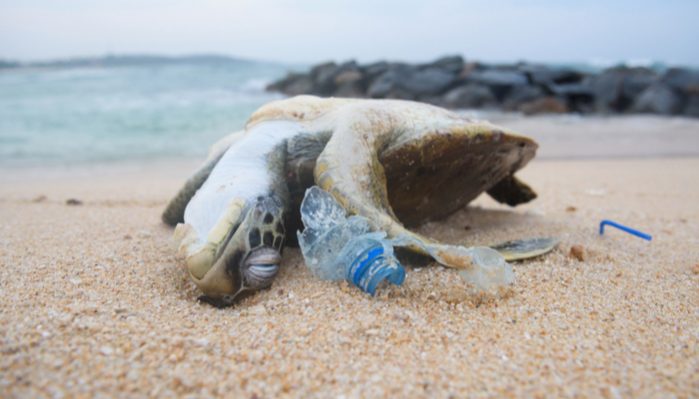
Plastic is particularly problematic because it’s nonbiodegradable and therefore sticks around for a lot longer (1,000 years) than other forms of trash.
Approximately 80% of marine litter actually originates on land—either swept in from the coastline or carried to rivers from the streets during heavy rain via storm drains and sewer overflows.
These plastics will not only kill more animals, but they will also decimate coral reefs, and damage human health as microplastics enter the food chain. They’ll create more and more significant dead zones where nothing can live, harm biodiversity, and change ecosystems.
Researchers have only been studying ocean plastics for less than two decades.
Who’s Responsible?
Around 80% of the 8 million tonnes of plastics come from land-based sources, with the remainder coming from shipping and the fishing industry. (9)
Major land-based sources are broken down into two sources: (9)
1. Primary Sources
Are the waste plastics from the manufacturing industry known as ‘nurdles’ or ‘mermaid’s tears’ – these small beads are transported in large volumes into the marine ecosystem. A new beach clean in Cornwall found 127,000 nurdles in a single clean.
2. Secondary Sources
Are plastic litter: bottles, food packaging, polyester clothing, fishing line – which is brought to the beach by wave action, river deposits, sewage outlets, and storm drains, as well as being directly deposited by beach users.
Are we Eating Our Own Plastic?
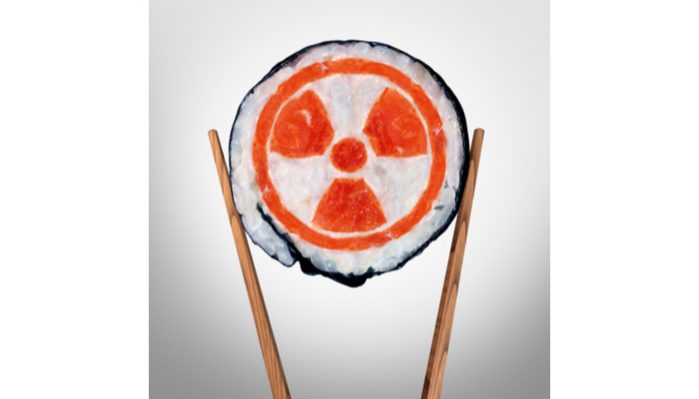
Yep! It is estimated that average consumers of seafood ingest around 11,000 pieces of microplastics per year, with over a third of all fish caught in the English Channel containing microplastics. There is increasing concern that this could adversely affect humans – although this is still being studied and debated. (9)
This recent BBC News video shows the moment that the plastic enters our food chain and starts its journey towards our own dinner plates. (9)
There’s Good News
Plastic is found in virtually everything these days, but there are ways you can make a difference.
1. Become More Mindful
Ninety percent of the plastic items in our daily lives are used once and then chucked: grocery bags, plastic wrap, disposable cutlery, straws, coffee-cup lids. (2)
TIP: Take note of how often you rely on these products and replace them with reusable versions. It only takes a few times of bringing your own bags to the store, silverware to the office, or travel mug to Starbucks before it becomes a habit. (2)
2. Stop Buying Water Bottles (please)
Bottled water produces 1.5 million tons of plastic waste per year, and these bottles require 47 millions gallons of oil to produce, according to Food & Water Watch. Carry a reusable bottle in your bag. If you’re nervous about the quality of your local tap water, look for a model with a built-in filter. (6)
TIP: Bring a reusable cup to coffee shops and ask the barista to fill it up, and keep a mug at your desk instead of using plastic, paper or Styrofoam cups. The average American office worker uses about 500 disposable cups a year so you’ll be preventing a lot of unnecessary waste. (6)
3. Recycle (duh)
It seems obvious, but we’re not doing a great job of it. For example, less than 14% of plastic packaging is recycled.
TIP: Confused about what can and can’t go in the bin? Check out Earth911.com’s recycling directory.
4. Support Bag Tax/Ban
Urge your elected officials to follow the lead of those in San Francisco, Chicago, and close to 150 other cities and counties by introducing or supporting legislation that would make plastic-bag use less desirable. (2)
5. Put Pressure on Manufacturers.
Though we can make a difference through our own habits, corporations obviously have a much bigger footprint. If you believe a company could be smarter about its packaging, make your voice heard. Write a letter, send a tweet, or hit them where it really hurts: Give your money to a more sustainable competitor. (2)
6. Just Say No To Straws
Inform your waiter/ess that you don’t need one, and make sure to specify this when ordering at a drive-thru.
TIP: Can’t fathom giving up the convenience of straws? Purchase reusable stainless steel or glass drinking straw.
7. Use Reusable Bags
About 1 million plastic bags are used every minute, and a single plastic bag can take 1,000 years to degrade. If you’re already bringing reusable bags to the grocery store, you’re on the right track! (12)
8. Bring Your Own
This may be a little hard to get used to in the beginning, but anytime you’re getting takeout or bringing home your restaurant leftovers, use your own reusable containers.
TIP: When you place your order, just ask if you can get the food placed in your own container. Most restaurants won’t have a problem with it.
9. Use Matches
If you need to light a candle, build a campfire, or start a fire for any other reason, opt for matches over disposable plastic lighters. These cheap plastic devices sit in landfills for years and have even been found in dead birds’ stomachs.
TIP: If you can’t bear to part with your lighter, pick up a refillable metal one.
10. Return Reusable Containers
If you buy berries or cherry tomatoes at the farmers market, simply bring the plastic containers to the market when you need a refill.
TIP: You can even ask your local grocer to take the containers back and reuse them. (13)
11. Make Your Own Juice
Instead of buying juice in plastic bottles, make your own fresh-squeezed juice or simply eat fresh fruit. Not only does this cut down on plastic waste, but it’s also better for you because you’ll be getting more vitamins and antioxidants and less high fructose corn syrup. (6)
12. Support Bans
Many municipalities around the world have enacted bans on single-use plastic bags, takeout containers, and bottles. You can support the adoption of such policies in your community. Here is a list of resources for legislative bodies considering limiting the use of plastic bags. (11)
13. Spread the Word
Stay informed on issues related to plastic pollution and help make others aware of the problem. Tell your friends and family about how they can be part of the solution, or host a viewing party for one of the many plastic pollutions focused documentaries, like Bag It, Addicted to Plastic, Plasticized, or Garbage Island. (11)
14. Support Organizations Addressing Plastic Pollution
There are many non-profit organizations working to tackle the problem of ocean plastic pollution in a variety of different ways, including Oceanic Society, Plastic Pollution Coalition, 5 Gyres, Algalita, Plastic Soup Foundation, and others. These organizations rely on donations from people like you to continue their important work. Even small donations can make a big difference! (11)
Bottom Line
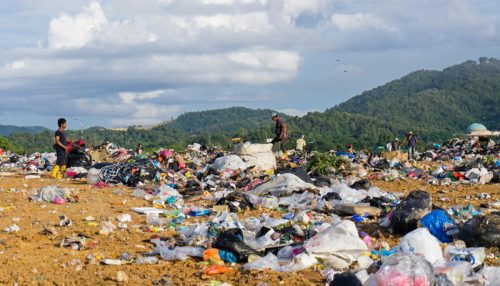
All over the world, people and businesses are waking up to the dangers created by single-use plastic. Now, we must demand a new era that prioritizes planet and people over profit and convenience. Let us continue to do our part! And hopefully, the world’s largest corporations will do theirs too. (5)
